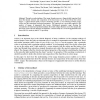10 search results - page 1 / 2 » Modeling Skin Blood Flow - A Neuro-physiological Approach |
IJCCI
2010
12 years 11 months ago
2010
MICCAI
2008
Springer
14 years 5 months ago
2008
Springer
Abstract. Obtaining high quality patient-specific flow velocity information is not an easy task. Available clinical data are usually poorly resolved and contain a significant amoun...
MICCAI
2002
Springer
14 years 5 months ago
2002
Springer
Through an understanding of the image formation process, diagnostically important facts about the internal structure and composition of the skin lesions can be derived from their c...
TOG
2008
13 years 3 months ago
2008
We introduce a layered, heterogeneous spectral reflectance model for human skin. The model captures the inter-scattering of light among layers, each of which may have an independe...
IJON
2006
13 years 4 months ago
2006
Abstract. Independent component analysis (ICA) of functional magnetic resonance imaging (fMRI) data is commonly carried out under the assumption that each source may be represented...

